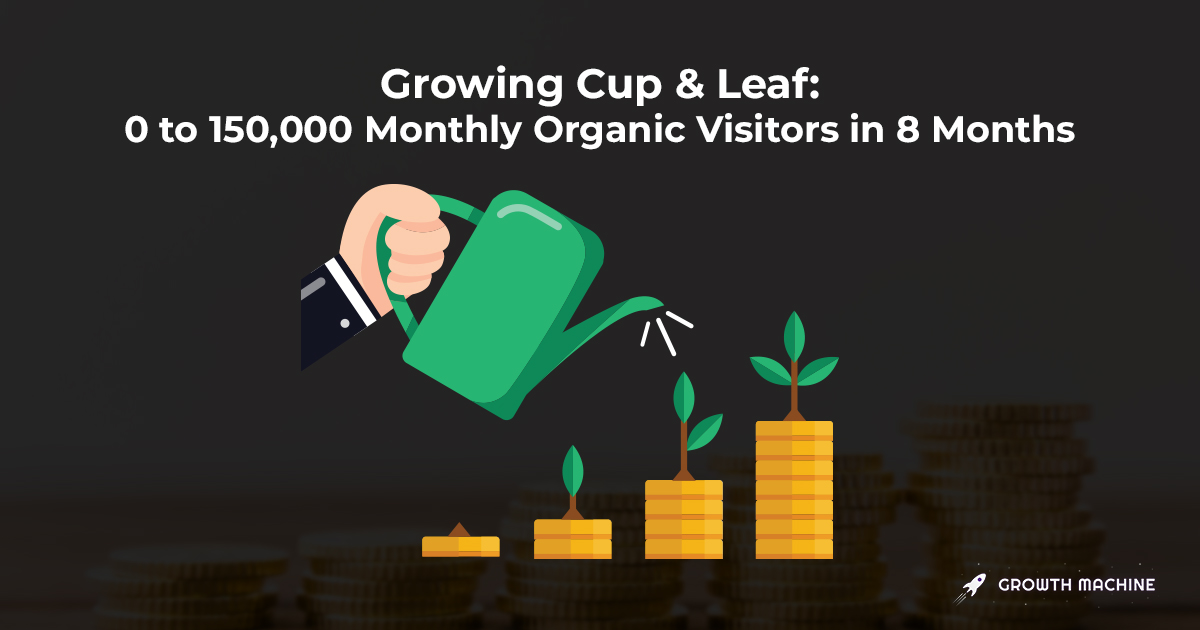SEO Case Study: 0 to 150,000 Monthly Visitors in 8 Months
At Growth Machine, we get companies more customers by getting them the top spots on Google for everything related to their brand.
The number one question we get when talking to potential clients is:
“What examples and case studies can you give us to prove you know what you’re doing?”
Up until a few months ago, the only response we had was to talk about results for past clients. Results on other people’s sites are great, but you always have to wonder how much help we got from things our clients were doing on their own.
What we wanted was a site we could point to and say: Here’s the site, here’s the traffic stats, we did it all in-house, see for yourself.
So eight months ago, we started a blog called Cup & Leaf as a side project.
And in that time, it’s grown from a tiny blog getting a few hits a day to one of the most popular tea-focused blogs on the Internet, bringing in over 150,000 visitors a month.

On top of that, it has a top spot on Google for some of the most valuable keywords related to tea, like “best oolong tea” and “best tea blog”:
In this article, I’m going to give an overview of how we did it, so you can start growing your blog to 100,000 monthly visitors or more.
And if you get to the end and decide you’d rather have us do this for your site for you, you can contact us here.
Choosing a Topic Area
The most important step for successfully growing a site to 100,000+ monthly viewers is picking a topic area where you can attract that many people.
That usually means your blog needs to meet three criteria:
First: It needs to have a large number of topics you can write about, so you don’t run out of article ideas.
Second: People need to be looking for those topics, so that as you create the articles and get them ranked you bring in new readers.
Third: It needs to not be too difficult to compete with other top sites for those rankings.
For example, we typically won’t work with sites that are trying to get ranked for topics related to “weight loss.”
Sure, there are tons of people searching for it, but it’s incredibly difficult to outrank them. Maybe we could with enough time and energy, but we’d rather go after the “big win” topics where we can get a ton of traffic with less effort.
At first glance, “tea” might seem like a weird choice. Haven’t Lipton and their competitors taken over all of the tea keywords?
It turned out the answer was no! Even though there are tons of people searching keywords like “green tea health benefits,” the tea-related topics were less competitive than we expected, making it a great area to go after.
So start by asking yourself those three questions. And if you’re still not sure whether your blog has SEO potential or not, this is a great guide for figuring it out.
Setting Up Your Blog for SEO Success
Second to picking a topic area, you want to make sure your blog is set up to perform well in Google search results.
The easy version of this is to just pick a WordPress template, host it on a cheap hosting provider like BlueHost, and go crazy.
We typically don’t recommend that though, for a few reasons:
- WordPress can get bulky and buggy as you add a bunch of plugins.
- It’s hard to customize on your own if you’re not a developer.
- Cheap hosts like BlueHost can make you a target (and in my case, a victim) of hackers.
If you want to give yourself the best odds of SEO success while sticking with WordPress, we’d recommend paying the extra money for a professional hosting provider like CloudOptimus or WPEngine.
Or, if you want to copy exactly what we did, then you can set your blog up on Webflow and follow this guide to make sure it’s SEO optimized.
Also, before you ask, yes, if you’re serious about getting SEO traffic, you shouldn’t use Medium, SquareSpace, Wix, WordPress.com, or any similar site builder that keeps your training wheels on.
Finding Your Target Keywords
A good target keyword will have a high enough search volume to bring in at least a few hundred visitors a month, and a low enough difficulty that you’re able to compete on it.
We go much, much more in-depth on this in our expanded 7-part series, but I’ll give you the highlights here.
A keyword is typically evaluated on its “Volume” and “Keyword Difficulty (KD).” Here’s what that looks like in Ahrefs:

We want to go after the keywords with low difficulty, and high volume, so on this list, “ginseng benefits” isn’t great:

But “types of tea” could be a huge home run:

You can keep track of all your keywords within your keyword research tool, but we like to pull them out to a spreadsheet so they’re easier to manage:

Before you can do that though, you need to know how to actually find the keywords. These are my three favorite techniques:
The Wiki Strategy
The wiki strategy is a great starting point for coming up with ideas. We also used some principles of this strategy with one of our clients whose informational website we helped get to 100,000 monthly visitors in six months. The idea is simple: You take some umbrella idea like “green tea,” and then think of everything related to green tea that could also be a keyword.
First, there’s everything related to green tea specifically, like “green tea benefits,” “caffeine in green tea,” “how to brew green tea,” “best green tea”…
Then there are the tangential topics, like “black tea,” “oolong tea,” and “rooibos tea,” which all have many of the same sub-topics as green tea.
And then there are the other less closely related topics like “tea steepers,” “history of tea,” caffeinated tea,” and so on.
If you’re using a keyword research tool like Ahrefs, or even Google’s free Keyword Planner, you can plug all of these ideas in and quickly get results on how difficult those keywords are and how many people are searching for them, which will give you a sense of which keywords to go after.
The “Also Rank For” Strategy
Once you have some keyword ideas from the wiki strategy, you can use those keywords as jumping off points to find other keywords.
If I go into Ahrefs and search for the keyword “green tea benefits,” I can click “Also rank for” on the left to see what pages that rank for “green tea benefits” also rank for:

By scrolling through this list, I can find a bunch of new keywords I might not have thought of before, and add them to my list:

And once I’m done going through the also-searched terms for this keyword, I can take any other keyword on my list and see what other keywords those pages rank for. This is a very, very fast way to come up with more keyword ideas once you already have a few.
But if you go through the Wiki Strategy and the “Also Rank For” Strategy, and still want more keywords, your next best bet is to get ideas from your competitors.
The Competitor Mining Strategy
If you want a top spot on Google, you’re taking that spot from someone else, which means there are sites that are already ranking for the topics you want your site to rank for.
Odds are you already know who your content competitors are. They’re blogs and sites that are the current authorities in your space, who you’re going to try to outrank with your content.
All you need to do is figure out what keywords and topics on their site are driving the most traffic.
You have a few options for this:
Ahrefs has a “Site Explorer” tool where you can see all the top keywords and pages for a site, which will give you a really good idea of what might be good keywords to go after:

Another option is to go to your competitors’ sites and browse around their different categories and blog articles. One of our big competitors for content is the Republic of Tea, so their blog categories might give us some ideas:

This is a great technique to come to when you start to run dry using the first two. You might discover a whole new category you hadn’t thought of, which can kickstart the Wiki and “Also Rank For” strategies.
Whatever combination of the three strategies you use, you should try to find at least 50 keywords before you move on. Once you do, you’ll be ready to start creating the content.
Creating Content That Ranks
Everything up until this point isn’t too difficult, and most people can do it fairly successfully.
The hard part isn’t the research or the promotion, it’s the writing. Most people are not as good of writers as they think they are, and are much less reliable about publishing than they think they are.
For Cup & Leaf, we published four posts per week, every week, for the last eight months, only stopping for holidays. And the posts are really good. If you can create good content on a reliable schedule, you’ll be ahead of 95 percent of the competition who are too lazy to write something in-depth on a consistent basis.
But it’s HARD. Don’t skip this step. Seriously. The spreadsheets and tools are fun, but this is where you really make or break your content strategy.
In fact, if you aren’t already publishing a few articles per week, I’d recommend just hiring a writer to help you. Having a good dedicated writer is going to make this strategy much more likely to succeed.
But whether you’re doing it yourself or working with a writer, the best way to create good SEO content is…
Creating the Best Article Online
If you want to get a top spot on Google, you need to be better than what’s already there.
Link building and on-page optimizations can make up for some lack of quality (just look at sites like Cosmo that rank well despite having terrible articles), but you need to create a great article if you want to get a top spot and stay there.
The simplest way to do that is to look at what everyone else in a top spot has in their articles and then do better.
That usually means some combination of:
- Adding more information
- Providing more up-to-date information
- Making your article more actionable
- Creating a more readable article
However you decide to beat out the top spots, you’ll need to take some time reading through them and seeing what they’re discussing and doing well before you write anything.
To make this easier, open up a blank document, and go through the top 5–10 results and take note of:
- All the topics they cover
- Anything you can think they left out
- Any unanswered questions you should answer
- How long, roughly, the articles are
- Anywhere you can provide more value
Alternatively, if you’re like me and want a tool to do this work for you, Clearscope is a great solution. They can figure out the top topics from the other sites you’re competing with.
However you do the research, once you feel like you have a good list of topics and improvements for the given keyword, you’ll be ready to write and publish your article.
Promoting Your Content
Here’s the dirty secret on promotion: We do very little of it.
A lot of promotion is busy work — stuff you do to feel productive when you’re really just waiting around for Google to start rewarding your hard work.
For example, we didn’t start tweeting or sharing posts on Facebook until about a week ago — almost nine months after we started publishing!

Instead, we focused on going after channels we knew could drive traffic, and that had a chance to give us sudden spikes in traffic. Primarily:
- Facebook groups
And those are the three channels we recommend to most of our clients now for targeted promotion. Here’s why.
There’s almost nowhere better on the internet for getting thousands of visitors overnight than Reddit. You won’t get that result 95 percent of the time, but every now and then you’ll play it right and your site will get the kind of traffic infusion it needs to get on Google’s radar.
Check out what happened when one of our articles did well in Reddit’s “howto” section:

That one-day spike in traffic gave our site more authority in Google’s eyes, and caused a number of pages to jump to the first page and start getting organic traffic. That’s including pages that weren’t promoted on Reddit!
But Reddit is hard, variable, and depressing. No matter how well your post does, people will probably be mean in the comments. And most of the time it won’t work. But when it does, you could see a big jump in rankings overnight.
To win on Reddit, the most important variable is having a good article that’s worth upvoting. If it looks like spam or it’s overly promotional, it won’t do well.
Next, you need to pick a community that allows links. Some only allow text, so you’ll need to hunt around a bit for one where you’ll be able to drop in the link.
Finally, try to post at a slower time and be responsive to comments. Comments as well as upvotes drive where an article ranks in other people’s feeds, so if you stay active and respond to comments, you’ll be more likely to do well.
Facebook Groups
Reddit gives you a low probability of getting a huge amount of traffic. Facebook groups give you a high probability of getting a small amount of traffic. As such, we see them as the perfect hedge against the unpredictability of Reddit, and as a way to generate some traffic to articles that would otherwise get seen by zero people.
The process is simple: first, you find some Facebook groups that might be interested in your articles.
Then, you join them and become a useful, engaged member. Don’t run in and start dumping links to your articles. You’ll most likely get instantly banned, or at the very least have your posts deleted.
As you continue being useful, watch for opportunities to provide links to your articles as comments, since comments are less likely to get flagged as spam (when they’re relevant) and still get lots of exposure.
Finally, on rare occasions, post one of your particularly good articles for the group and see what kind of response you get.
This strategy won’t drive tons of traffic, but it’s a good way to get an extra few hundred visitors a week, which can move the needle with your SEO in the beginning before your site is ranking.
Pinterest is special because it’s the only strategy here that compounds in an interesting way.
As you grow your Pinterest following, more people will see each of your pins. But also as you add more pins, there are more things for other people to pin. And the more other people pin your pins, the more people see those pins and pin them themselves…you get the idea.
So far our Pinterest has grown to sending about 100 visitors a day to our site:

It’s not a ton compared to what we’re getting from SEO, but it does help get traffic to new articles that aren’t ranking, and we think there’s value in getting the Cup & Leaf brand out there in this highly visual format since it might help with downstream acquisitions.
Those are the big promotion channels working for us right now, but there’s one other kind of promotion everyone always asks about: backlinks.
Building Backlinks
Confession time: we did very little in the way of building backlinks to Cup & Leaf. It was a much smaller focus for us than Reddit, Facebook groups, and of course, creating great content.
Here’s what we did do though.
Backlinking from Owned Assets
I’m the first to admit this isn’t a technique everyone can replicate, but it is a good demonstration of how investing in blogging over time pays off.
The first places we linked to Cup & Leaf was from sites that we already owned:
- I linked to it from www.nateliason.com
- I linked to it from www.yourgrowthmachine.com
- Nora linked to it from www.acleanbake.com
- I redirected an old site, www.natlikestea.com, to it
Again, I know not everyone can copy this part of the strategy, but if you have sites you can link to your other sites with, you should use them.
Interviews and Guest Posts
Next, we used text and podcast interviews as a way to build backlinks. I didn’t go after the interviews specifically to get backlinks, but whenever I was doing one, I made sure to mention Cup & Leaf, which usually got us a backlink from the show notes.
I did the same thing with guest posts. If I was doing a guest post related to SEO, I’d talk about the work we were doing on Cup & Leaf as an example, which gave me a good excuse to link to it.
Broken Links
We also did a bit of broken link building, since there was a massive medical resource that took down their whole site, leading to a ton of broken links we could go after. I don’t think this resulted in more than five links though, and it was the only “active” link building we did.
Waiting
Our biggest source of backlinks has been patience. Since our pages are starting to rank, they’re getting cited as resources by writers on other blogs who want to cite something. That’s been bringing in 5–10 links per week now, without us doing anything. Link building is really a positive feedback loop: The more link you have, the more links you get.
The Biggest Ingredient: Patience
There are a few big reasons I see people fail to get traffic like this.
One is content quality. If your articles aren’t really, really good, they probably won’t rank. It’s essential to have high-quality content for this kind of strategy to work.
But after content quality, I’d argue the next most important aspect is patience. A lot of people give up way too early, and miss out on seeing these kinds of results. The Cup & Leaf growth curves are really sexy, but those first few months didn’t feel too great.
Consider that we now get more traffic in one day than we used to get in an entire month.

If you’re not willing to spend a few months posting content with no results, and feeling like you’re just burning money, you won’t make it.
Because SEO, unlike ads, has extreme long-term value. A single article might cost a couple hundred dollars, but once it’s ranked, it brings in traffic every day, potentially for years.
Even if an article only brings in 30 visitors a day, over a month that’s almost a thousand people, and over two years it would be around 22,000. And most of our articles bring in a lot more than 30 people a day.
So if you’re going to go down this path, be ready to wait. Even if you get more aggressive about backlinks than we did, you’re not going to see tens of thousands of organic visitors overnight.
And if you do want to try this for yourself, then our 7-part series going more in-depth on each step is a great place to start.
Or, We Can Do It for You
I’d also be doing myself a disservice if I didn’t mention that we can also just do this for you, since this kind of SEO-focused content marketing is what we’ve built our whole agency on.
If you’re interested, just fill out our contact form.







